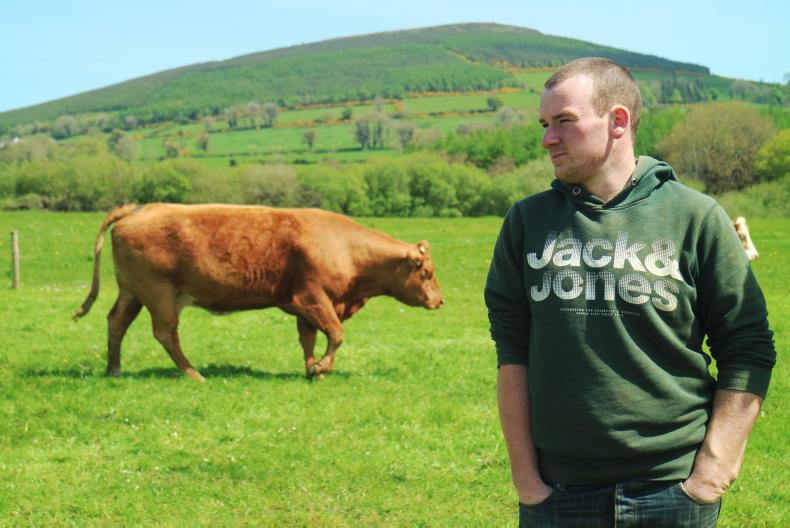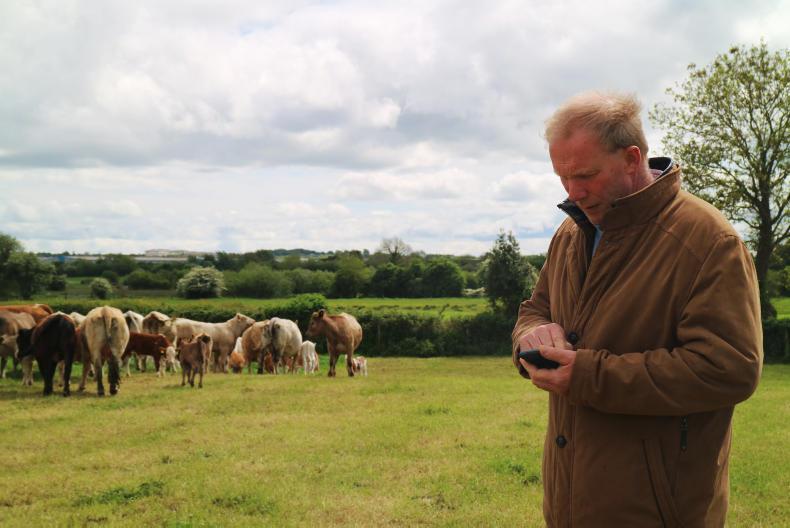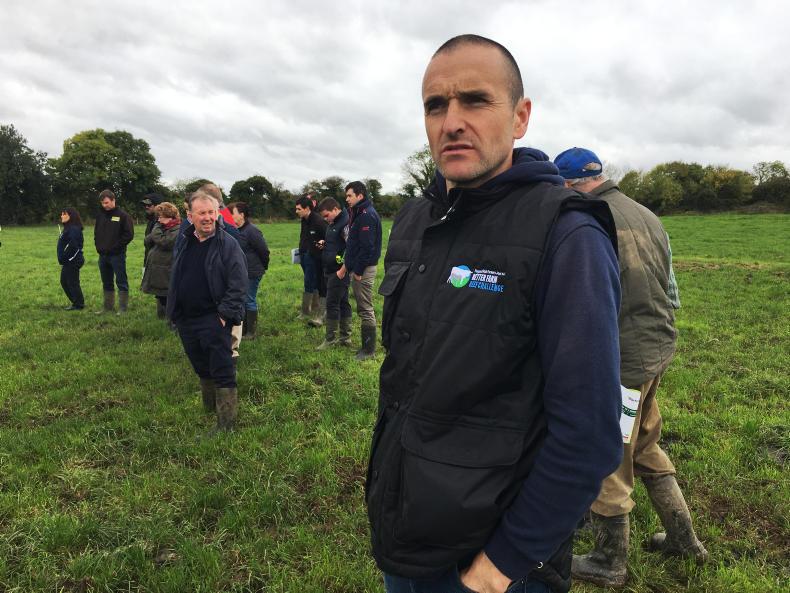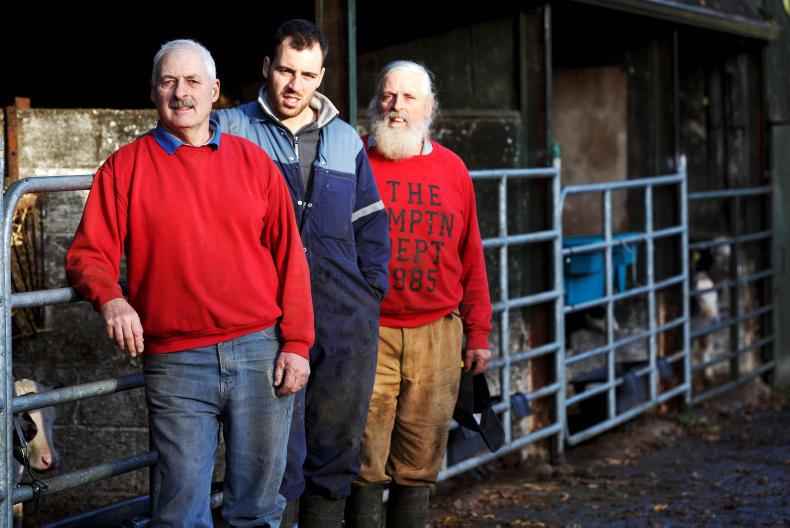High: Dairy beef bliss in Laois
In Laois, Harry Lalor’s bought-in dairy calves performed excellently this grazing season. Harry took in 26 Hereford-cross females with an average date of birth of 7 March.
“The calves came in at two to three weeks of age and we reared them on a 26% crude protein milk replacer.
They were weaned at eight to 10 weeks of age. They started on six litres of milk replacer and towards the end of rearing I gradually reduced the volume of water going into the mixture, but not the powder.
It was like yoghurt towards the end, but the calves were still eating a good portion of meal by the time weaning came,” Harry said.
Harry offered just shy of 1kg of concentrate to calves at grass during the grazing season – a 25kg bag between the group – and rotationally grazed them in such a way that the utmost amount of leaf was kept in the sward at all times.
Calves went into covers of 8-10cm, with heavy swards skipped for bales.
At this young age, these types of calves are not adept grazers.
From birth to 6 November, Harry’s calves achieved 0.82kg of weight gain daily, coming in to shed well on target at 236kg on average.
“They’re getting 68% DMD silage, 1.5kg of meal and 6kg of beet now. I want to drive some of them on with a view to breeding next summer. I’d hope to do a draft in a few weeks, pull out the 15 best and drop the feeding on the rest,” he added.
Low: pneumonia woes in Thomastown

Michael McDonald is Kilkenny’s representative in the BETTER farm beef programme. The 24-year-old ran 72 sucklers on 60ha this year.
The herd calved from mid-July to mid-September.
The passionate cattle breeder ran into trouble in recent weeks, losing a calf to a bout of pneumonia.
“I had vaccinated them for IBR and dosed them for worms when housing time came.
The calves were also creeping out away from the cows to a paddock at their own leisure.
I noticed a cough in the group on a Monday and by Wednesday calves were off their feed. I had to treat eight animals altogether. It hit them very hard; you couldn’t take your eyes off them.
I lost a lovely little Aubrac heifer calf. She got very dull and went downhill all of a sudden, her lungs were destroyed,” Michael told me.
On veterinary advice, Michael vaccinated all of his calves intranasally against Pi3 and RSV.
“They’ve responded well to the vaccination and, touch wood, there have been no problems since.
It put a slight dampener on what was a good year here. I managed to get on top of my calving spread and move to an all-autumn calving system, from a split one, in a short space of time.
“We are almost finished a new shed and we went from strip-grazing through 10 field divisions to having 50 permanent divisions on the farm.
Low: bull trouble in Offaly

On the outskirts of Portarlington, Co Offaly, BETTER farmer John Dunne fell foul of stock bull trouble this summer. He runs one of the biggest operations in the BETTER farm beef programme, at almost 300 acres.
“I normally have great luck with bulls here, but this year was a bit of a disaster for my heifers. My Angus bull normally runs with them, but he got hurt after a couple of weeks of the breeding season. I had to replace him at short notice and purchased a young Hereford bull in Nenagh.
He came fully fertility tested and spent eight weeks of the 12-week season with the heifers. Unfortunately, when scanning time came around the results were very disappointing,” John said.
“He was running with 31 animals, but only 17 were in-calf at the end of the season. Granted, there were two females that the scanner deemed unsuitable for breeding, but it’s still damning.
“What’s next?” I asked John.
“I was very happy with that bull when I bought him, visibly, and his figures were great for a Hereford. But, the proof is in the pudding and the fact is that there’s not a lot of pudding there to eat. My feeling now is to see how calving goes. If his calves come easy and are good we’ll test him again and give him another go. Maybe he was just too immature going to the heifers.
“I’ve had an exceptional run with bulls here in recent years. Even this year, my other bulls ran with 93 cows and I had a 98% in-calf rate in 12 weeks.” John said.
He has purchased five in-calf heifers to regain some of the lost ground and is currently fattening the empties.
“There are no passengers here,” John said.
High: grass explosion in Thurles
The Stanleys run the largest farm in the BETTER farm beef programme, with over 300 cattle acres on the holding. Dwayne, his father Raymond and uncle Gilbert farm full-time here.
There are currently 110 cows calving on the Stanley farm, with 65 calving in the spring and 45 in the autumn. The plan is to push this to 120 cows.
In addition, the Stanleys will take in 100 to 120 dairy calves for rearing – again, split between spring and autumn.
In 2016, a 21.5ac field adjacent to the main yard got three grazings: 25 cows and calves were let in for three weeks at a time.
BETTER farm programme manager Alan Dillon earmarked this field for reseeding straight away.
“On 27 March this year, we sprayed off the field and the cows went in to clean it out.
On 22 April, it was tilled twice with a power harrow and two days later the power harrow went in again and it was sowed with the Premium Gold grass mixture,” Dwayne told me.
This mixture is described as being ideal for grazing or one-cut silage and contains Tyrella (strong for spring growth), Soriento (excellent ground cover attributes), Dunluce (good grass quality), Trend (one of the highest yield varieties), Aran (clover) and Aberherald (clover).
The field got 3t of lime/acre before, and three bags of 10:10:20 after sowing.
Soil tests on the ground in late 2016 showed low index (1/2) for P and K and a pH of around 6.0 (target 6.3).
“On 20 June, 48 2017-born dairy calves went in and two days later 31 of our own weanlings went in as followers. We installed three permanent troughs along the middle of the field and are splitting the field currently with poly wire.
“There are 10 divisions in the field now,” Dwayne said.
“We actually had to let suckler cows and calves in for a while when growth was really strong earlier this summer.”
Raymond added: “I can’t get over the grass we’re growing with the paddock system. We installed water points all over the farm and though it was a big investment, it has unleashed the farm’s potential to produce grass.
“We have made 260 unplanned bales of silage this year.”
On the reseed, the Stanleys’ dairy calves gained 0.71kg daily during the grazing seaon, while their followers gained 1.05kg.
High: shed revamp in Charleville
Autumn calver Kieran Noonan is one of the Cork representatives in the BETTER farm programme. An AI technician by trade with Munster AI, he keeps a herd of 50 suckler cows.
Half of Kieran’s cows are pedigree and he enjoys a degree of success selling breeding stock. This culminated in the sale of a Limousin bull (LM4302) by Wilodge Cerberus from one of his Castleview-bred cows to an AI company in late 2016.
However, later that winter Kieran’s young calves were hit hard during their first period indoors with respiratory problems. While he didn’t lose any animals, thrive was severely hit.
Weight gain
His birth to 200-day weight gain was 40% to 50% lower than what an autumn-calver with his type of animal should be aiming for, at 0.57kg/day.
Straight away, the BETTER Farm management team identified flaws in the design of his housing. There wasn’t enough airflow in and out of the building to keep stale air moving and prevent the accumulation of disease-causing agents. There was also a degree of overcrowding in the building.
A number of adaptions were made to Kieran’s cattle shed.
While the roof sheets were spaced, a capped opening along the apex of the shed’s roof was installed to create a bigger air outlet.
While vented sheeting is better than a solid wall, the value of some types of vented side sheets as a means for letting in air is questionable. Kieran replaced these with wind-breaker netting, leaving an inlet gap at the top of the wall.
An extension to Kieran’s shed is almost complete. This will act as a lie-back for young calves and act to dilute Kieran’s stocking rate to a degree.
Different shed
“The change already this winter is significant. You can tell yourself, it’s like walking into a different shed. There’s no ammonia smell and the animals seem much brighter. I had to inject a couple of young calves early on, but that was more down to the clammy weather I think. When the new lie-back is finished they’ll have much more room,” Kieran told me.
Low: catastrophic calving in Athboy

Under 16-month bull producer Joe Healy began his tenure in the BETTER farm beef programme having already achieved a gross margin in excess of €1,000/ha across 44ha in 2016.
However, calving 2017 will be remembered for all the wrong reasons. Joe lost nine calves, via a combination of abortions, animals born dead, deformities, weak calves and freak deaths after a couple of days.
Initially, it was feared that a rare strain of bacteria called Streptoccus pluranimalium, last documented in Scotland in 2011 and known to cause sporadic abortions, was the root of Joe’s problem.
Neospora
However, since the initial analysis, a more definitive lab result indicated the presence of neospora in one of Joe’s cows. She has been culled, along with all but two of the others who lost calves. The remaining pair are rearing three bought-in beef cross dairy calves between them.
The test also showed up a presence of IBR within the herd, a disease which is accredited with causing abortions in cows. The whole herd has since been vaccinated.
“It’ll be a year to forget, but you can’t let these things get you down. Farming throws these curveballs at you every now and again that you have to take on the chin and move on from,” Joe said.
Aside from the calving woes, it has been a great year since for Joe. His bull calves have achieved 1.22kg of daily weight gain from birth and his heifers 1.07kg. His under-16-month bulls averaged 413kg carcase weight and he has erected a new cattle shed. In an effort to boost output, he has also bought in 29 bulls for finishing.
“They’re currently doing 1.4kg a day on 4kg of meal with good baled silage,” he told me.
Read more
Watch: contract dairy heifer rearing in Tyrone
Big gains made from steady progress
High: Dairy beef bliss in Laois
In Laois, Harry Lalor’s bought-in dairy calves performed excellently this grazing season. Harry took in 26 Hereford-cross females with an average date of birth of 7 March.
“The calves came in at two to three weeks of age and we reared them on a 26% crude protein milk replacer.
They were weaned at eight to 10 weeks of age. They started on six litres of milk replacer and towards the end of rearing I gradually reduced the volume of water going into the mixture, but not the powder.
It was like yoghurt towards the end, but the calves were still eating a good portion of meal by the time weaning came,” Harry said.
Harry offered just shy of 1kg of concentrate to calves at grass during the grazing season – a 25kg bag between the group – and rotationally grazed them in such a way that the utmost amount of leaf was kept in the sward at all times.
Calves went into covers of 8-10cm, with heavy swards skipped for bales.
At this young age, these types of calves are not adept grazers.
From birth to 6 November, Harry’s calves achieved 0.82kg of weight gain daily, coming in to shed well on target at 236kg on average.
“They’re getting 68% DMD silage, 1.5kg of meal and 6kg of beet now. I want to drive some of them on with a view to breeding next summer. I’d hope to do a draft in a few weeks, pull out the 15 best and drop the feeding on the rest,” he added.
Low: pneumonia woes in Thomastown

Michael McDonald is Kilkenny’s representative in the BETTER farm beef programme. The 24-year-old ran 72 sucklers on 60ha this year.
The herd calved from mid-July to mid-September.
The passionate cattle breeder ran into trouble in recent weeks, losing a calf to a bout of pneumonia.
“I had vaccinated them for IBR and dosed them for worms when housing time came.
The calves were also creeping out away from the cows to a paddock at their own leisure.
I noticed a cough in the group on a Monday and by Wednesday calves were off their feed. I had to treat eight animals altogether. It hit them very hard; you couldn’t take your eyes off them.
I lost a lovely little Aubrac heifer calf. She got very dull and went downhill all of a sudden, her lungs were destroyed,” Michael told me.
On veterinary advice, Michael vaccinated all of his calves intranasally against Pi3 and RSV.
“They’ve responded well to the vaccination and, touch wood, there have been no problems since.
It put a slight dampener on what was a good year here. I managed to get on top of my calving spread and move to an all-autumn calving system, from a split one, in a short space of time.
“We are almost finished a new shed and we went from strip-grazing through 10 field divisions to having 50 permanent divisions on the farm.
Low: bull trouble in Offaly

On the outskirts of Portarlington, Co Offaly, BETTER farmer John Dunne fell foul of stock bull trouble this summer. He runs one of the biggest operations in the BETTER farm beef programme, at almost 300 acres.
“I normally have great luck with bulls here, but this year was a bit of a disaster for my heifers. My Angus bull normally runs with them, but he got hurt after a couple of weeks of the breeding season. I had to replace him at short notice and purchased a young Hereford bull in Nenagh.
He came fully fertility tested and spent eight weeks of the 12-week season with the heifers. Unfortunately, when scanning time came around the results were very disappointing,” John said.
“He was running with 31 animals, but only 17 were in-calf at the end of the season. Granted, there were two females that the scanner deemed unsuitable for breeding, but it’s still damning.
“What’s next?” I asked John.
“I was very happy with that bull when I bought him, visibly, and his figures were great for a Hereford. But, the proof is in the pudding and the fact is that there’s not a lot of pudding there to eat. My feeling now is to see how calving goes. If his calves come easy and are good we’ll test him again and give him another go. Maybe he was just too immature going to the heifers.
“I’ve had an exceptional run with bulls here in recent years. Even this year, my other bulls ran with 93 cows and I had a 98% in-calf rate in 12 weeks.” John said.
He has purchased five in-calf heifers to regain some of the lost ground and is currently fattening the empties.
“There are no passengers here,” John said.
High: grass explosion in Thurles
The Stanleys run the largest farm in the BETTER farm beef programme, with over 300 cattle acres on the holding. Dwayne, his father Raymond and uncle Gilbert farm full-time here.
There are currently 110 cows calving on the Stanley farm, with 65 calving in the spring and 45 in the autumn. The plan is to push this to 120 cows.
In addition, the Stanleys will take in 100 to 120 dairy calves for rearing – again, split between spring and autumn.
In 2016, a 21.5ac field adjacent to the main yard got three grazings: 25 cows and calves were let in for three weeks at a time.
BETTER farm programme manager Alan Dillon earmarked this field for reseeding straight away.
“On 27 March this year, we sprayed off the field and the cows went in to clean it out.
On 22 April, it was tilled twice with a power harrow and two days later the power harrow went in again and it was sowed with the Premium Gold grass mixture,” Dwayne told me.
This mixture is described as being ideal for grazing or one-cut silage and contains Tyrella (strong for spring growth), Soriento (excellent ground cover attributes), Dunluce (good grass quality), Trend (one of the highest yield varieties), Aran (clover) and Aberherald (clover).
The field got 3t of lime/acre before, and three bags of 10:10:20 after sowing.
Soil tests on the ground in late 2016 showed low index (1/2) for P and K and a pH of around 6.0 (target 6.3).
“On 20 June, 48 2017-born dairy calves went in and two days later 31 of our own weanlings went in as followers. We installed three permanent troughs along the middle of the field and are splitting the field currently with poly wire.
“There are 10 divisions in the field now,” Dwayne said.
“We actually had to let suckler cows and calves in for a while when growth was really strong earlier this summer.”
Raymond added: “I can’t get over the grass we’re growing with the paddock system. We installed water points all over the farm and though it was a big investment, it has unleashed the farm’s potential to produce grass.
“We have made 260 unplanned bales of silage this year.”
On the reseed, the Stanleys’ dairy calves gained 0.71kg daily during the grazing seaon, while their followers gained 1.05kg.
High: shed revamp in Charleville
Autumn calver Kieran Noonan is one of the Cork representatives in the BETTER farm programme. An AI technician by trade with Munster AI, he keeps a herd of 50 suckler cows.
Half of Kieran’s cows are pedigree and he enjoys a degree of success selling breeding stock. This culminated in the sale of a Limousin bull (LM4302) by Wilodge Cerberus from one of his Castleview-bred cows to an AI company in late 2016.
However, later that winter Kieran’s young calves were hit hard during their first period indoors with respiratory problems. While he didn’t lose any animals, thrive was severely hit.
Weight gain
His birth to 200-day weight gain was 40% to 50% lower than what an autumn-calver with his type of animal should be aiming for, at 0.57kg/day.
Straight away, the BETTER Farm management team identified flaws in the design of his housing. There wasn’t enough airflow in and out of the building to keep stale air moving and prevent the accumulation of disease-causing agents. There was also a degree of overcrowding in the building.
A number of adaptions were made to Kieran’s cattle shed.
While the roof sheets were spaced, a capped opening along the apex of the shed’s roof was installed to create a bigger air outlet.
While vented sheeting is better than a solid wall, the value of some types of vented side sheets as a means for letting in air is questionable. Kieran replaced these with wind-breaker netting, leaving an inlet gap at the top of the wall.
An extension to Kieran’s shed is almost complete. This will act as a lie-back for young calves and act to dilute Kieran’s stocking rate to a degree.
Different shed
“The change already this winter is significant. You can tell yourself, it’s like walking into a different shed. There’s no ammonia smell and the animals seem much brighter. I had to inject a couple of young calves early on, but that was more down to the clammy weather I think. When the new lie-back is finished they’ll have much more room,” Kieran told me.
Low: catastrophic calving in Athboy

Under 16-month bull producer Joe Healy began his tenure in the BETTER farm beef programme having already achieved a gross margin in excess of €1,000/ha across 44ha in 2016.
However, calving 2017 will be remembered for all the wrong reasons. Joe lost nine calves, via a combination of abortions, animals born dead, deformities, weak calves and freak deaths after a couple of days.
Initially, it was feared that a rare strain of bacteria called Streptoccus pluranimalium, last documented in Scotland in 2011 and known to cause sporadic abortions, was the root of Joe’s problem.
Neospora
However, since the initial analysis, a more definitive lab result indicated the presence of neospora in one of Joe’s cows. She has been culled, along with all but two of the others who lost calves. The remaining pair are rearing three bought-in beef cross dairy calves between them.
The test also showed up a presence of IBR within the herd, a disease which is accredited with causing abortions in cows. The whole herd has since been vaccinated.
“It’ll be a year to forget, but you can’t let these things get you down. Farming throws these curveballs at you every now and again that you have to take on the chin and move on from,” Joe said.
Aside from the calving woes, it has been a great year since for Joe. His bull calves have achieved 1.22kg of daily weight gain from birth and his heifers 1.07kg. His under-16-month bulls averaged 413kg carcase weight and he has erected a new cattle shed. In an effort to boost output, he has also bought in 29 bulls for finishing.
“They’re currently doing 1.4kg a day on 4kg of meal with good baled silage,” he told me.
Read more
Watch: contract dairy heifer rearing in Tyrone
Big gains made from steady progress









 This is a subscriber-only article
This is a subscriber-only article















SHARING OPTIONS: